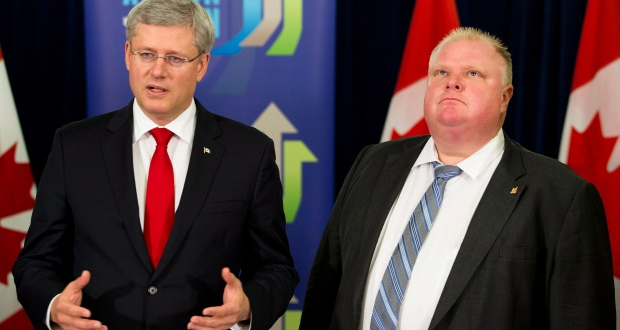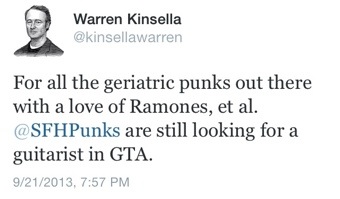In Tuesday’s Sun: a picture is worth 1,000 words – and one video
It’s a bit of Kremlinology admittedly, and therefore an inexact science. But that photo of Prime Minister Stephen Harper and Toronto Mayor Rob Ford? It’s a shocker.
To some of us, it was astonishing. Not because they have differing ideologies, of course. Both men are hardcore Conservatives. Not because there is a personal animus between the pair. Harper has previously attended Ford family barbecues to sing the mayor’s praises — and the mayor, for his part, hero-worships Harper.
Not because Harper was in Toronto to pledge dollars for Ford’s much-trumpeted subway extension to East Toronto. Harper has long enabled Ford’s subway fixation.
Not because Ford looks — as always — like a man out of place and time, flushed and staring off into space while Harper spoke.
No, the Harper-Ford photo was surprising because it happened at all.
Toronto’s mayor, as the entire planet knows by now, has been in a spot of trouble for the past few months. A Toronto newspaper and a U.S. website alleged, as fact, that they had seen a video of Ford smoking crack cocaine.
Lots of things happened after that shocker, but one thing — tellingly — didn’t happen: Ford suing the news organizations in question.
Falsely alleging a crime is the most serious form of libel. But Ford didn’t sue.
If he’d done so and won, he’d capture one of the biggest libel judgments in Canadian history. But he didn’t.
That fact, alone among many facts in the sad Rob Ford saga, said plenty.
It suggested the allegations about a crack video would remain, dogging Ford at every turn. Politicians — even fellow Conservatives — therefore did all they could to avoid being photographed with Ford.
That all ended with the Harper-Ford get-together.
There is no way on God’s green earth — none — the RCMP, and/or the Canadian law enforcement/intelligence community, would have let Harper get that close to Ford if the latter was facing an imminent criminal charge, or proof of involvement in a serious crime.
The RCMP’s Protective Policing Service is sworn to protect the prime minister in every way.
Under Harper, the Prime Minister Protection Detail has ballooned in size. New weapons, big armoured-plated vehicles and many more gun-toting Mounties are a presidential-style hallmark of the Harper era.
Most significantly, however, its mandate has remained protecting the prime minister “at all times,” in public and private. And, “the RCMP continuously assesses the security requirements, and as a matter of practice makes recommendations to the prime minister with respect to the effective delivery of security measures.”
The RCMP aren’t perfect. They have, in the past, let Harper get too close to some bad apples — most notoriously accused fraudster Arthur Porter and guilty-pleading money launderer, Nathan Jacobson.
But, since the debacle surrounding an assassination attempt on Jean Chretien in 1995, they have done a pretty good job.
So why would the Mounties allow Stephen Harper anywhere near Rob Ford?
Because they have formed the opinion that, lawsuits or not, the infamous crack video is — as its owner later told that same Toronto newspaper and U.S. website — “gone.”
Pictures say more than words. The Harper-Ford picture says plenty.
Namely, the video is gone, baby, gone.


